Clik here to view.

A couple of weeks ago, I took a business trip to New York City for all kinds of exciting Shiksa-related meetings. On the trip, I also made it my mission to explore the Manhattan Jewish deli scene. The history of Jewish deli food is totally fascinating. To prepare for my trip, I read the book “Save the Deli” by David Sax. David gives an in-depth history of Jewish delicatessen, explaining the historical roots of Yiddish Jewish cuisine and America’s deli culture. The book is a must-read for anybody interested in Jewish deli food. The book’s descriptive, delicious prose left me primed and ready to enjoy some tasty deli treats.
Image may be NSFW.
Clik here to view.
One thing I have learned in my years of researching Jewish food is that Jewish delis are rarely kosher. In Save the Deli, Sax explains that the expense of keeping a restaurant kosher and the politics of kosher certification turned many deli owners away from the kosher standard:
Though kosher Jews will say, with unwavering conviction, that the only true delicatessen is a kosher delicatessen, what predominate in New York today are Jewish-owned, Jewish-operated, Jewish-patronized, non-kosher delicatessens. Among them are some of New York’s best-known delis, including Junior’s, Katz’s, Carnegie, and the Stage. Some kosher-style delis may have stopped being kosher for economic reasons; some were simply never kosher. They were opened by those who wanted no part of the complicated, expensive, and often hypocritical world of kosher certification.
I was only able to visit seven delis on this trip (including all of those listed by Sax in the paragraph above). I was pretty busy with meetings and events, so I missed out on some crowd favorites like Russ and Daughters and Yonah Schimmel’s Knishes Bakery— tragic, considering this is a knish blog. Unfortunately I had to stick to Manhattan and the neighborhoods I was already visiting for other reasons, and my time was limited. I didn’t have a chance to make it out to Brooklyn, even though I know some of the best East Coast delis are out there. If your favorite deli is not on my list, fear not—I will certainly visit it in the future!
I decided to try a knish in each deli to compare the different ways Jewish cooks approach the Art of Knish. I’m excited to tell you about my experiences! But first, a little history…
Image may be NSFW.
Clik here to view.
The Lower East Side tenement district, early 1900’s
Between 1880 and 1920, roughly 2 millions Jews immigrated to the United States from Eastern Europe and Russia. In his book, Sax explains that knishes became popular fare for these new American Yiddish communities:
Suddenly, the foods of a people dispersed for nearly two thousand years came together in one corner of Manhattan. Romanians tasted the dishes of Poles and Litvaks, Russians cooked for Ukranians and Germans. Early on, the preferred vehicle for Yiddish food was the pushcart. In many cases, the wife would pickle, bake, or cook in the cramped tenement apartment at night, and the husband would sell the food all day. Soon, enterprising shopkeepers and suppliers began making bulk amounts of foods in their stores, selling them to armies of pushcart peddlers to distribute around the neighborhood. Foods needed to be cheap, preserved (because there wasn’t refrigeration), and easily eaten by hand. Most customers were garment workers, who are at their sewing machines or on the street. The most popular items were knishes, black breads, ryes and bagels, pickled herring (wrapped in newspaper), salamis, other cold cured meats, and pickles.
I’ve made and tasted knishes many times over the years, sharing recipes with family and friends and modifying my own recipes as I go along. One thing I’ve learned is that everybody makes a knish differently. There is no “one way” to make a knish—you’ll see that in the pictures I’m posting here. Some people like doughy knishes, some flaky, some biscuit-y. Some people like small bite-sized knishes, while others prefer big, overstuffed pastries. The most popular filling is potato, with kasha as a close second. I’ve seen knishes filled with meat, cheese, spinach, liver, and even sweet fillings like fruit. Knishes are a creative way to use up leftovers; indeed, I wouldn’t be surprised if the first knish was invented for just this purpose. In other words, if you have some extra brisket from Shabbat dinner and you’re not sure how to use it—why not stuff a knish with it? Get creative. If you can imagine an ingredient tasting good encased in a savory pastry, it will make a great knish!
Here are the delis I was able to visit on my trip:
Carnegie Deli
Ben Ash
Stage Deli
Juniors
Zabar’s
The 2nd Avenue Deli
Katz’s Deli
I also visitied Sammy’s Romanian, another famous Jewish food landmark—but that experience deserves its own blog. 😉
As you might guess, I came back from my deli trip two pounds heavier. But it was totally worth it. While I’ve made and tasted knishes many times over the years, this was my first experience comparing deli-style knishes. I can safely say I ended my trip with a broader understanding of knish. Now I’d like to share what I learned with you!
First stop…
CARNEGIE DELI
Image may be NSFW.
Clik here to view.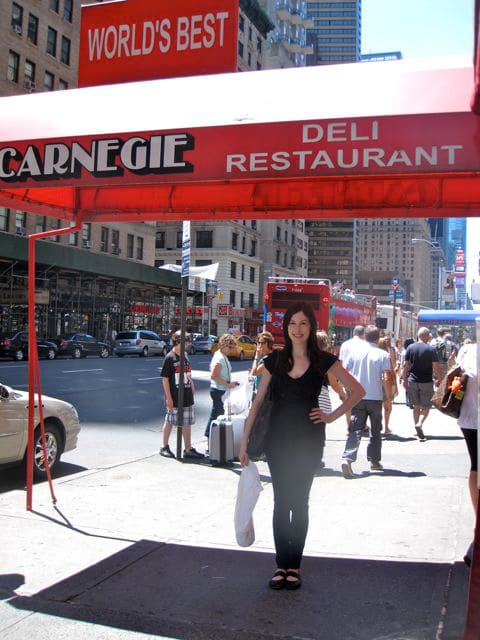
Me outside Carnegie Deli
For my first breakfast in Manhattan, I visited the famous Carnegie Deli on 7th Avenue. The Carnegie opened in 1937 and has been serving hungry Manhattan natives and tourists for over 70 years. I’ve been to Carnegie many times, but this visit was different. I was on a mission.
I ordered my favorite deli breakfast—a toasted egg bagel with cream cheese and lox. On the side I ordered two knishes, one potato and one kasha.
Image may be NSFW.
Clik here to view.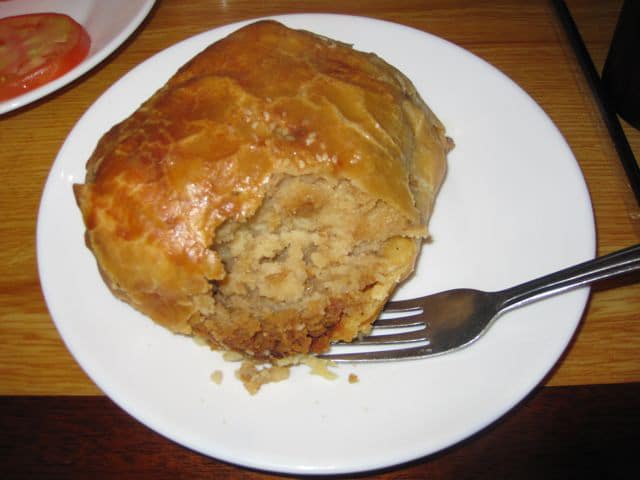
Did I over-order? Of course. But I dug in with gusto.
The crust of both knishes was thin and slightly chewy with the attractive sheen of a yellow egg wash. The potato knish had been reheated a bit too long—a piece of the crust was tough and overdone. The filling was fluffy, salty and oniony—in other words, yummy. I noticed that there were a few sesame seeds sprinkled on top, which is something I do when making burekas, not knishes. But as I said, everybody does this knish thing differently.
The kasha knish was very similar to the potato one—same crust, same color, same texture. But the filling, a mix of whole grain kasha and mashed potatoes, was totally unappealing to me. A kasha knish can be great if it’s done right. This kasha knish tasted old and stale, somehow. Not great.
Image may be NSFW.
Clik here to view.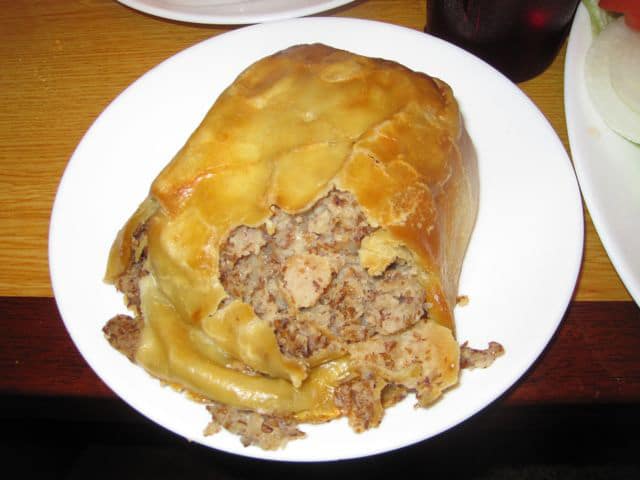
I’m happy to report that the bagel and lox were delicious! The portions were enormous. My fiance and I enjoyed potato knish and bagel leftovers for a midnight snack. 🙂
BEN ASH
Image may be NSFW.
Clik here to view.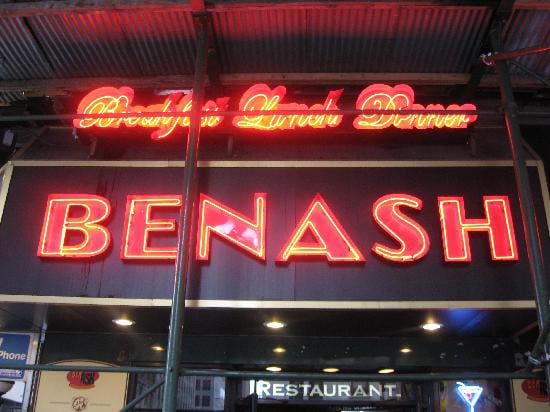
Ben Ash sits right across the street from Carnegie Deli, luring in unsuspecting tourists when Carnegie is too busy to seat them. I had tried Ben Ash once before years ago and hadn’t been impressed. But it was just around the corner from our hotel, so I figured I’d give it another shot.
I should have turned around when I saw only three customers there at the breakfast hour. Now I can say with certainty I will never go back. The round knish they gave me tasted stale and flavorless—the filling was bland, the crust was rubbery, and it was totally greasy. It wouldn’t be worth mentioning here, but this is a knish blog, so I thought I’d give you a heads up.
Image may be NSFW.
Clik here to view.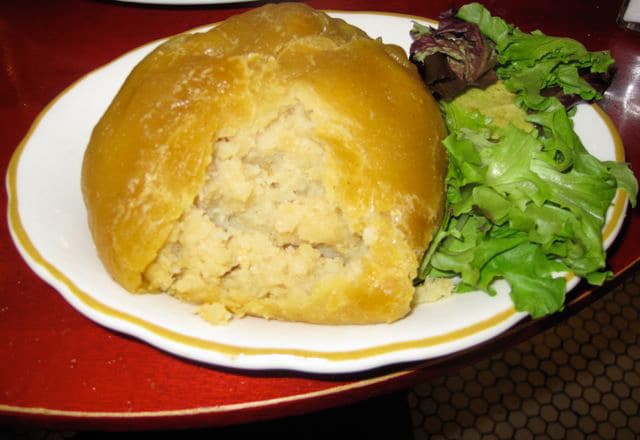
If you’re checking out delis in NY, skip Ben Ash. It’s overpriced and underwhelming. Thank goodness I didn’t go for the $26 “Ben Ash Reuben Giant Knish” topped with pastrami and sauerkraut, I can only imagine how awful that might have been.
STAGE DELI
Image may be NSFW.
Clik here to view.
Just down the street from Carnegie is another New York landmark, Stage Deli. Like Carnegie, it opened in 1937 and quickly became a favorite with the Broadway crowd because of its proximity to Times Square. From their website:
The Stage Deli began its ascent to gastronomic fame in 1937 when Max Asnas, a Russian émigré, opened a modest little delicatessen on the corner of Broadway and 48th Street. Mr. Asnas stocked his deli with the foods of his native land—blintzes, salamis, smoked fish and thick loaves of Russian rye bread. Because of his quick wit and despite what some may have considered a “slightly gruff” manner, Max Asnas soon became the toast of Broadway. Actors from the nearby theaters strolled into The Stage in between rehearsals. Vaudeville comedians partook of his gargantuan corned beef sandwiches and The Stage Deli soon became known as the place to be—and the place to be seen.
I decided to try a square fried knish at the Stage. Here’s a pic:
Image may be NSFW.
Clik here to view.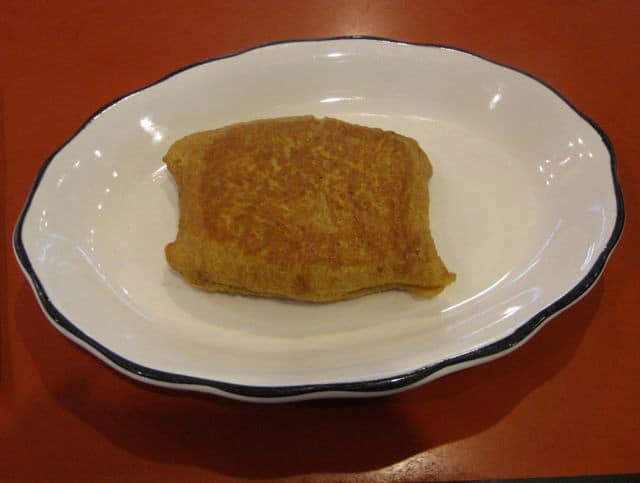
It was decent—a simple potato filling encased in thick, biscuit-like dough, baked and then fried. The filling could have used more seasoning to my taste, but it wasn’t bad…just slightly boring. I was still in search of a truly satisfying knish.
JUNIORS
Image may be NSFW.
Clik here to view.
I was told by some friends that I shouldn’t miss Juniors, a huge deli-like restaurant in the heart of Times Square. I say deli-like because Junior’s isn’t really a deli, though they do serve some Jewish dishes on the menu like latkes, blintzes, and chopped liver (they call the latkes “potato pancakes”—oy vey). I stopped by to check it out, and was told by the friendly host that they don’t have knishes on the menu. He convinced me to try one of their “famous cheesecake” slices instead. I ordered it to go, stuck it in the hotel mini fridge, and ate it in my room that evening. It was too rich and overly sweet for my taste, though I’m sure others might disagree. Cheesecake is what made Junior’s famous, after all.
Image may be NSFW.
Clik here to view.
I left Juniors feeling annoyed that my deli experience so far had been pretty underwhelming.
ZABAR’S
Image may be NSFW.
Clik here to view.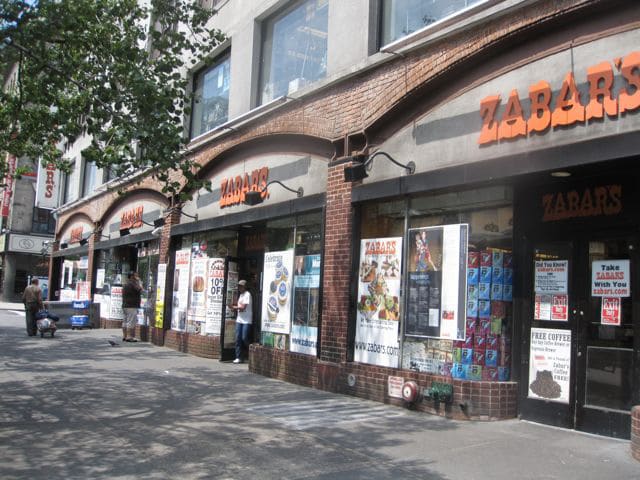
Here’s where the trip takes a definite turn in the RIGHT direction. I headed over to Zabar’s on the Upper West Side, hoping against hope that my knish experience would improve. Thankfully, it did!
Zabar’s is an incredible gourmet shop located on Broadway and 80th for over 70 years. Though not quite a “deli” per say, it has been owned by a Jewish family for generations. From their website:
In 1934 Louis and Lillian Zabar started Zabar’s by renting an Appetizing Counter in a Daitch Market. Louis had a philosophy. He would sell only the highest quality smoked fish at a fair price. He wanted his customers to trust him and he wanted them to become “regulars.” He traveled to the smokehouses and sampled the smoked fish himself. He refused much more than he accepted. He developed a reputation of being hard to please. Over the years Lillian and Louis took over the Daitch Market – and Zabar’s was born. Louis worked long hours; he roasted his own coffee. He hand selected every item that Zabar’s sold – always wanting to give his customers the best available at a “fair” price. The store was his life.
Louis Zabar’s hard work paid off. Over the years the store flourished, expanding and taking over an entire city block. A family run affair, their website claims there is “always a Zabar in the store.” The store now sells all kinds of Jewish favorites, from lox to bagels to—you guessed it—knishes! Zabar’s knish selection is the largest I’ve ever seen. They are truly “gourmet” knishes. Here’s a pic of their knish and strudel wall:
Image may be NSFW.
Clik here to view.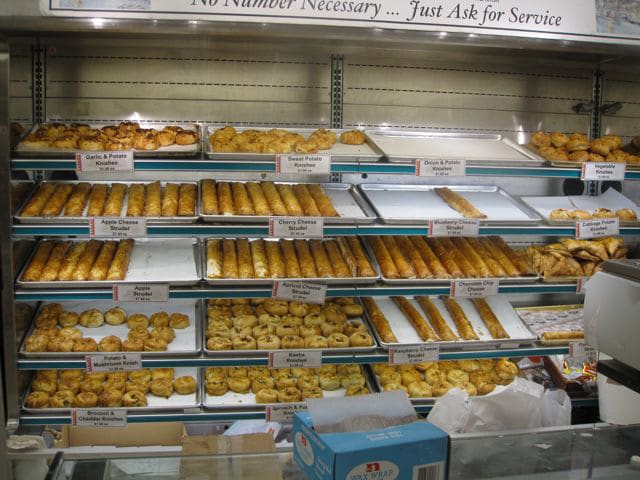
I wanted to try one of everything, but I settled for a spinach potato knish because I had to pace myself (I had three deli stops to make in one day)! Here’s the knish I enjoyed.
Image may be NSFW.
Clik here to view.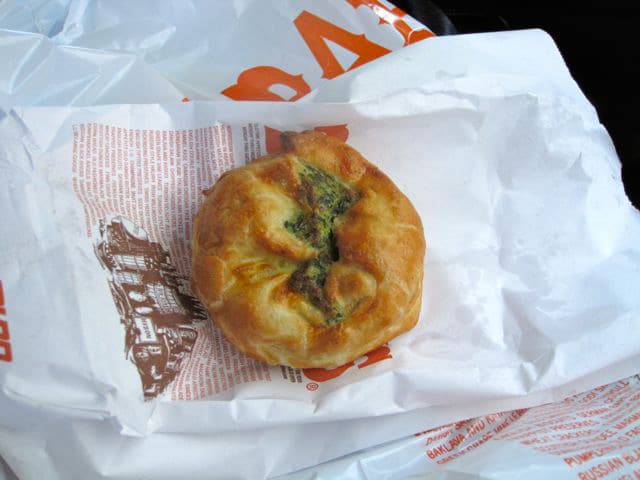
It was flaky, delicious, divine—the perfect pastry, a flavorful filling, a wonderful way to start my deli day.
For those of you who don’t live in an area that has great knishes, Zabar’s has a mail order service. Yummy! Highly recommended.
THE SECOND AVENUE DELI
Image may be NSFW.
Clik here to view.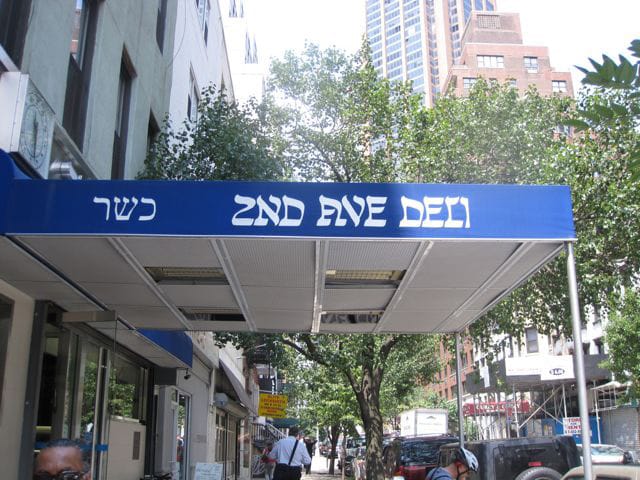
The 2nd Avenue Deli holds a special place in my heart. Of all the delis I visited on my trip, 2nd Avenue manages to maintain a wonderful old-fashioned neighborhood deli feeling. From the time I entered to the time I left, I was made to feel welcome—like one of the family. There’s a sense of nostalgia in the place, even though it recently opened in a new location (so it’s technically no longer on 2nd Avenue).
The history of the 2nd Avenue is well known to most New Yorkers. If you’re unfamiliar with the story of Abe Lebewohl, the legendary deli owner and Mensch whose life ended far too soon, please read the following article from the New York Times:
The food—what can I say? It was authentic, delicious. You could feel the love and care that went into making these dishes. 2nd Avenue is a kosher deli—no real dairy products are served on the premises. They maintain their kosher tradition proudly, and I can’t say I missed the dairy one bit. The food at 2nd Avenue was the best I’d had on my trip so far. And they didn’t certainly didn’t want me to leave hungry! Before I’d left, they’d served me samples of their famous cholent, some sweet chopped liver on toasted rye crackers, and a little chocolate soda. Delish!
Image may be NSFW.
Clik here to view.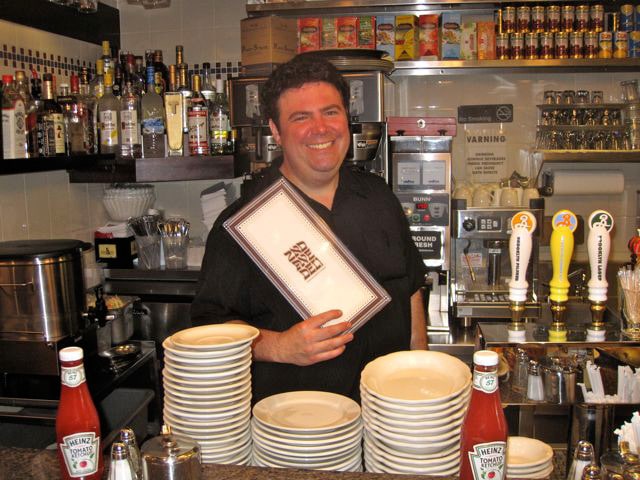
Brad, the counterman, told me that the 2nd Avenue Deli makes their knishes both round and square. Traditionally round knishes are baked and square knishes are fried. I tried one of each, both stuffed with potato. The round was my favorite, but both were excellent. The Zabar’s knish was more sophisticated in terms of pastry quality, but the 2nd Avenue knishes had an authenticity you couldn’t replicate. They’re the real deal; biscuit style dough, tasty soft and fluffy potato filling, perfectly warmed. They tasted fresh, not like they’d been tossed from the freezer to the microwave. Add to that a Dr. Brown’s cream soda and I was in knish heaven.
Image may be NSFW.
Clik here to view.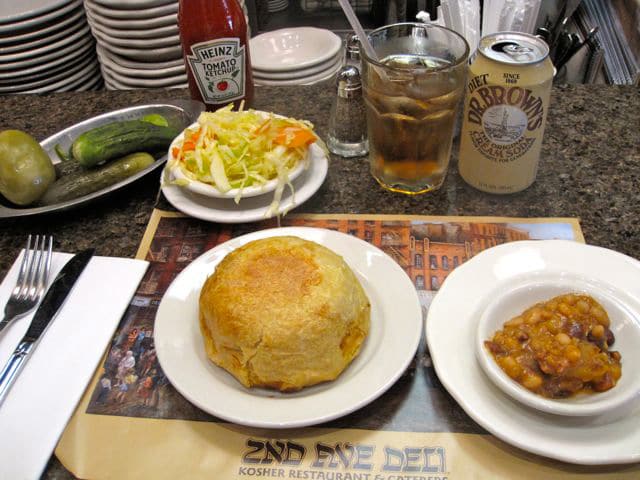
I left the deli feeling full and happy in both body and spirit. It was by far my favorite deli on the trip, and I plan to make it a regular stop on my future trips to New York. You should, too—in honor of Abe Lebewohl. If you stop there, have a knish for me. 🙂
KATZ’S DELI
Image may be NSFW.
Clik here to view.
I ended my trip with a self-guided tour of the Lower East Side tenement district and a visit to Katz’s Deli. Katz’s is the oldest deli in New York City, and I’m guessing it might be the oldest in the world, too. It was opened in 1888 by the Lustig family, not long after Jewish immigrants began flooding Ellis Island. In 1916 it was bought by Benny and Harry Katz, two German Jewish brothers. They changed the name to Katz’s Deli and moved it across the street to the location where it remains today. You’ve probably seen the inside of Katz’s deli, even if you don’t realize it. The famous “I’ll have what she’s having” scene from When Harry Met Sally took place at Katz’s. From presidents to celebrities to heads of state, everybody who’s anybody has eaten at Katz’s. It’s an experience not to be missed.
Image may be NSFW.
Clik here to view.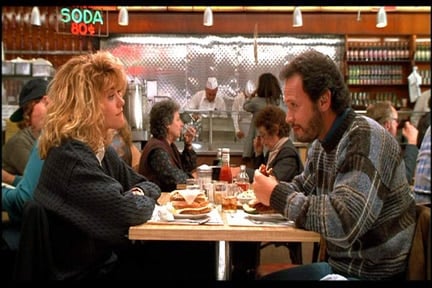
I’d done my research. I knew exactly what I wanted to order—a pastrami on rye with spicy mustard. I ordered the meat “juicy lucy” style, meaning I asked for the fatty cut (not lean). I normally eat pretty healthy, but how often do you have an opportunity to eat at Katz’s? I wanted the real deal. And boy, did I get it.
Image may be NSFW.
Clik here to view.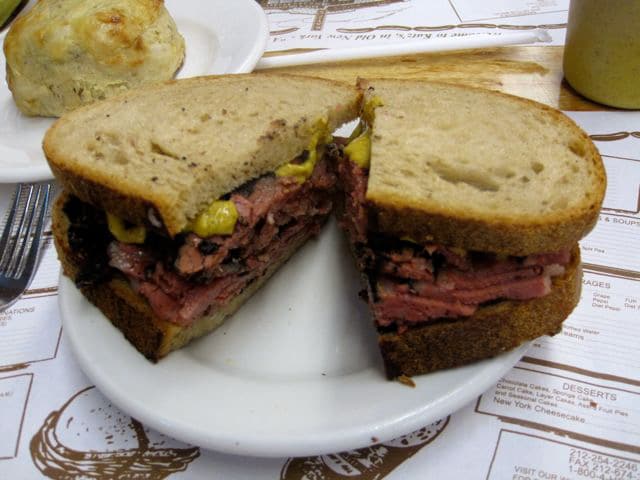
The meat was moist and tender, melt-in-your-mouth delicious. The bread was soft and fluffy. The pickles were some of the best I’ve had. I smothered the meat in spicy mustard, just as it should be. Here I am enjoying my sandwich and my life!
Image may be NSFW.
Clik here to view.
My fiance had the corned beef sandwich. It was great, too… but we both had to agree that the pastrami was really something special.
Of course, I had to order a knish too; a round one (baked) on the advice of our waiter. It was pretty good—on par with the Stage and Carnegie Deli knishes. But 2nd Avenue and Zabar’s definitely had the Katz knish beat.
Image may be NSFW.
Clik here to view.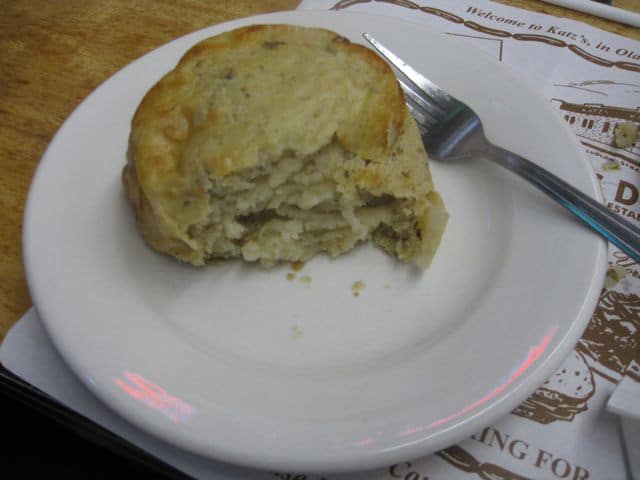
For those of you familiar with Katz’s, you might enjoy knowing that I sent a salami to my boy in the army. Actually, I don’t have a boy in the army, so I asked them to send one out to a deserving soldier. Somewhere out there, a soldier received a salami from the Shiksa in the Kitchen. I hope they enjoyed it half as much as I enjoyed my pastrami on rye.
Katz’s Deli marked the end of my week in Manhattan and my knish adventure. I can’t wait to go back and try more amazing Jewish delis!